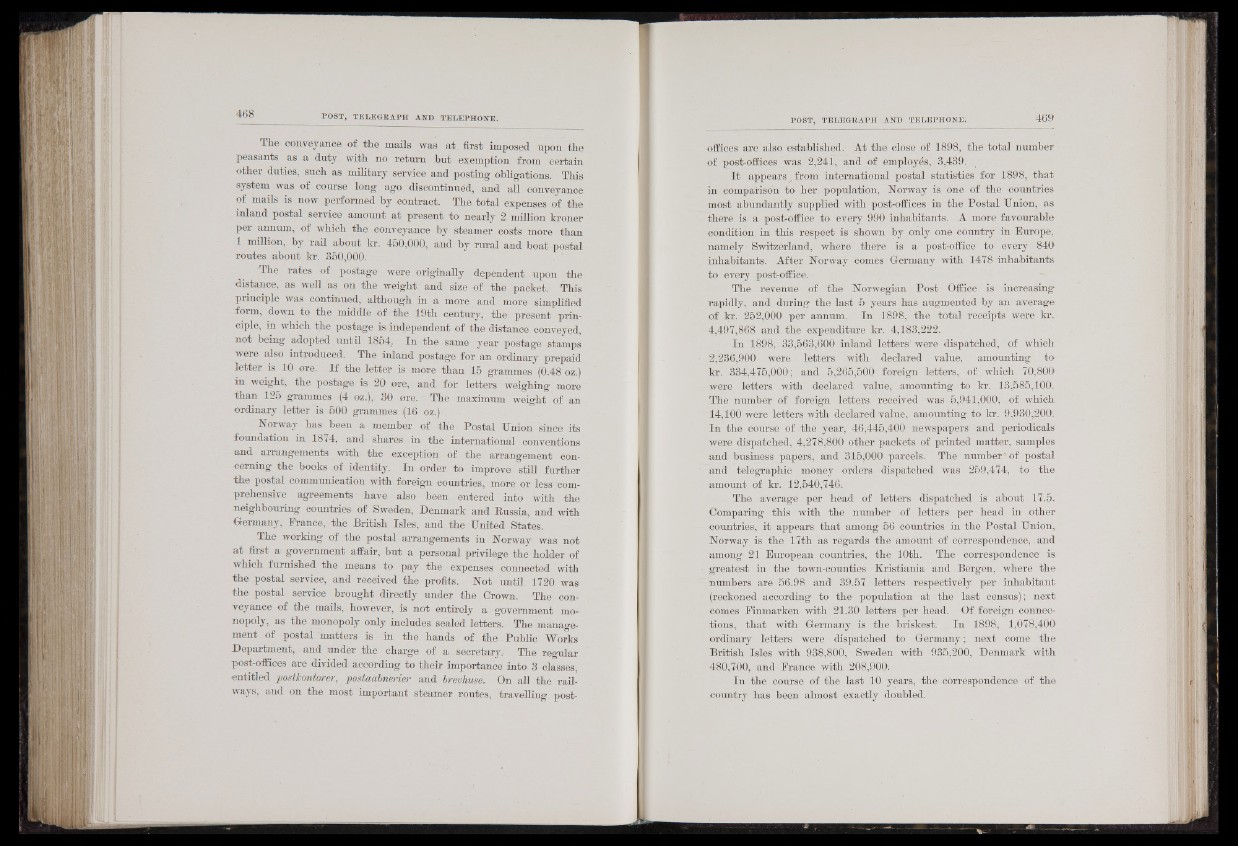
The conveyance of the mails was at first imposed upon the
peasants as a duty with no return but exemption from certain
other duties, such as military service and posting obligations. This
system was of course long ago discontinued, and all conveyance
of mails is now performed by contract. The total expenses of the
inland postal service amount at present to nearly 2 million kroner
per annum, of which the conveyance by steamer costs more than
1 million, by rail about kr. 450,000, and by rural and boat postal
routes about kr. 350,000.
The rates of postage were originally dependent upon the
distance, as well as on the weight and size of the packet.- This
principle was continued, although in a more and more simplified
form, down to the middle of the 19th century, the present principle,
in which the postage is. independent of the distance conveyed,
not being adopted until 1854. In the same year postage stamps
were also introduced. The inland postage for an ordinary prepaid
letter is 10 ore. If the letter is more than 15 grammes (0.48 oz.)
in weight, the postage is 20 ore, and for letters weighing more
than 125 grammes (4 oz.)v 30 ore. The maximum weight of an
ordinary letter is 500 grammes (16 oz.)
Norway has been a member of the Postal Union since its
foundation in 1874, and shares in the international conventions
and arrangements with the exception of the arrangement concerning
the books of identity. In order to improve still further
the postal communication with foreign countries, more or less comprehensive
agreements have also been entered into with the
neighbouring countries of Sweden, Denmark and Russia, and with
Germany, Prance, thè British Isles, and the United States.
The working of the postal arrangements in Norway was not
a t first a government affair, but a personal privilege the holder of
which furnished the means to pay the expenses connected with
the postal service, and received the profits. Not until 1720 was
the postal service brought directly under the Crown. The conveyance
of the mails, however, is not entirely a government monopoly,
as the monopoly only includes sealed letters. The management
of postal matters is in the hands of the Public Works
Department, and under the charge of a secretary. The regular
post-offices are divided according to their importance into 3 classes,
entitled postkontorer, postaabnerier and brevhuse. On all the ra.il-
ways, and on the most important steamer routes, travelling postoffices
are also established. At the close of 1898, the total number
of postoffices was 2,241, and of employés, 3,439.
I t appears from international postal statistics for 1898, that
in comparison to her population, Norway is one of the countries
most abundantly supplied with post-offices in the Postal Union, as
there is a post-office to every 990 inhabitants. A more favourable
condition in this respect is shown by only one country in Europe,
namely Switzerland, where there is a post-office to every 840
inhabitants. After Norway comes Germany with 1478 inhabitants
to every post-office.
The revenue of ' the Norwegian Post Office is increasing
rapidly, and during the last 5 years has augmented by an average
of kr. 252,000 per annum. In 1898, the total receipts were kr'
4,497,868 and the expenditure kr. 4,183,222.
In 1898, 33,563,600 inland letters' were dispatched, of which
2,236,900 were letters with declared value, amounting to
kr. 334,475,000; and 5,265,500 foreign letters, of which 70,800
were letters with declared value, amounting to kr. 13,585,100.
The number of foreign letters received was 5,941,000, of which
14,100 were letters with declared value, amounting to kr. 9,930,200.
In the course of the year, 46,445,400 newspapers and periodicals
were dispatched, 4,278,800 other packets of printed matter, samples
and business papers, and 315,000 parcels. The number* of postal
and telegraphic money orders dispatched was 259,474, to the
amount of kr. 12,540,746.
The average per head of letters dispatched is about 17.5.
Comparing this with the number of letters per head in other
countries, it appears that among 56 countries in the Postal Union,
Norway is the 17th as regards the amount of correspondence,. and
among 21 European countries, the 10th. The correspondence is
greatest in the town-counties Kristiania and Bergen, where the
numbers are 56.98 and 39.57 letters respectively per inhabitant
(reckoned according to the population at the last census); next
comes Einmarken with 21.30 letters per head. Of foreign connections,
that with Germany is the briskest. In 1898, 1,078,400
ordinary letters were dispatched to Germany ; next come the
British Isles with 938,800, Sweden with 935,200, Denmark with
480,700, and France with 208,900'.
In the course of the last 10 years, the correspondence of the
country has been almost exactly doubled.